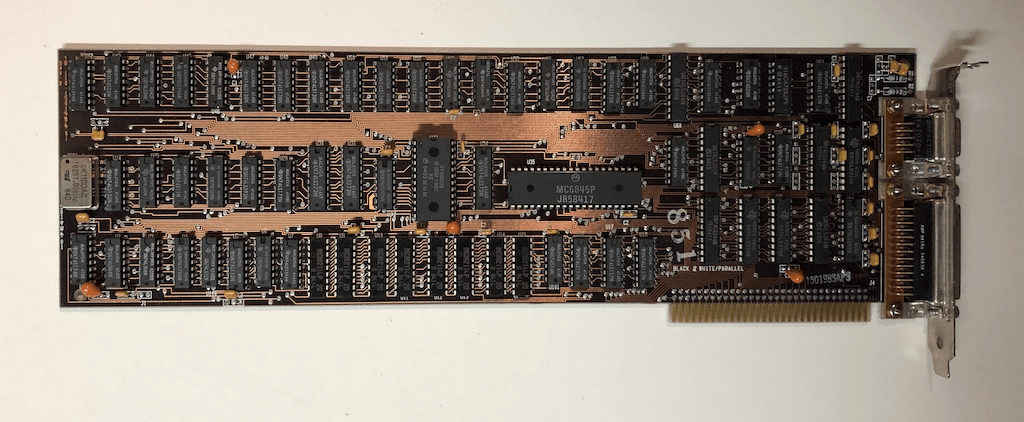In the more than 25 years between 1980 and 2006, the graphics card developed into what it is today: by far the most important component for gamers. It all started with 4 KByte DRAM in the ISA slot and culminated with the lightning-fast GeForce 8800 GTX (test). A look back at the milestones.
Table of contents
- 1 C: B_retro Ausgabe_80 Die_Geschichte_der_Grafikkarte
- The history of the graphics card
- It all began in the ISA slot
- The milestones
- MDA (“Monochrome Display Adapter” ) from 1981
- HGC (“Hercules Graphics Card”) from 1982
- ATi 16899-0 (“EGA Wonder”) from 1988
- ATi Mach32/Mach64 from 1992
- 3dfx Voodoo (SST-1) from 1996
- Nvidia Riva128 from 1997
- C:B_retroFeedback
- Feedback is always welcome
- C: B_retro Review
- An overview of the last ten issues
C: B_retro Ausgabe_80 Die_Geschichte_der_Grafikkarte
In the first part of this series, C: B_retro takes a close look at the early graphics cards between 1980 and 1997. The second part will shed light on the developments from 1998 to 2006.
The history of the graphics card
At the beginning of the personal computer, the graphics card as such was rather ridiculed, as the PC usually served as a work device and the monitor for outputting ASCII characters in 25 lines and 80 columns. It was only with the increased emergence of graphical user interfaces and games that the graphics card also gained in importance and developed into one of the most important components.
It all began in the ISA Slot
In the early early stages of the PC, IBM itself still manufactured graphics cards for the ISA slot, but these worked according to the MDA (“Monochrome Display Adapter”) standard and offered a pure text mode. At that time, around 1981, each character was still assigned fixed 9 × 14 pixels and the total resolution was a maximum of 720 × 348 pixels To be able to do this, an optional graphics card was required that supported the new standard CGA (“Color Graphics Adapter”).
This gave the user either 160 × 100 pixels with 16 colors or 320 × 200 pixels with 4 colors. Hercules was one of the first manufacturers to offer graphics cards that support both standards, MDA and CGA.
The Milestones
< h3 class = "text-width text-h3" id = "section_mda_monochrome_display_adapter_von_1981"> MDA (“Monochrome Display Adapter”) from 1981
IBM defined the first graphics card standard with the appearance of the IBM PC in 1981. However, the “graphics card” was used exclusively for single-color text display and individual characters with 9 × 14 pixels.
- 80 characters, 25 columns
- 720 × 348 pixels in monochrome
- 8 KByte ROM for 256 ASCII characters
- 4 KByte DRAM
 MDA (” Monochrome Display Adapter “) from IBM (Image: vgamuseum)
MDA (” Monochrome Display Adapter “) from IBM (Image: vgamuseum) HGC (“Hercules Graphics Card”) from 1982
The “Hercules Graphics Card” worked optionally with the MDA or CGA standard and was able to control pixels individually for the first time. Up to 16 colors could be displayed at the same time.
- 80 characters, 25 columns
- 720 × 348 pixels in monochrome
- 320 × 200 pixels with 4 colors
- 160 × 100 pixels with 16 colors
- 8 KByte ROM for 256 ASCII characters
- 64 KByte DRAM
The graphics cards from Hercules replaced the MDA graphics cards with their CGA standard from 1984 at the latest and established a first standard with” Hercules Compatible “, which was also valid for gamers. image__wrap “style =” max-width: 630px “> 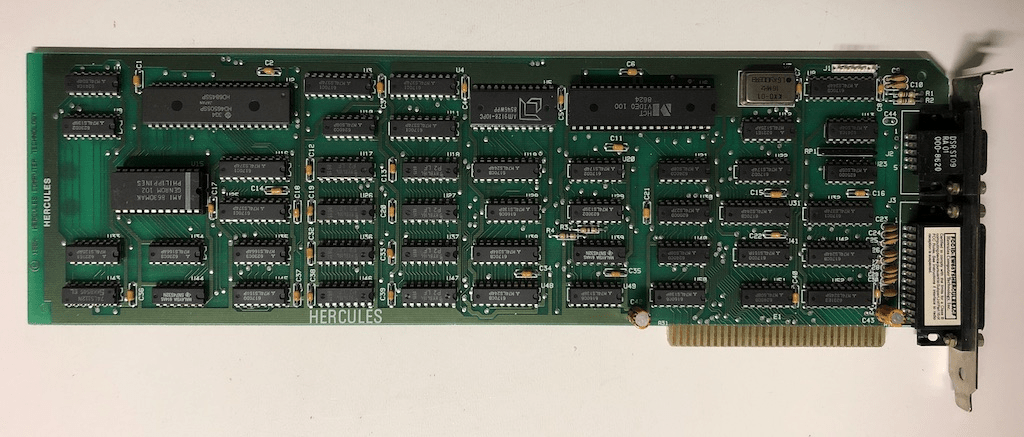 HGC (“Hercules Graphics Card”) (picture: vgamuseum)
HGC (“Hercules Graphics Card”) (picture: vgamuseum)
ATi 16899-0 (“EGA Wonder”) from 1988
One of the early graphics cards from ATi was the 16899-0 (“EGA Wonder”), which, depending on the model, already mastered the EGA or VGA standards and, with 256 KByte DRAM, also the early graphics cards was clearly superior in terms of video memory.
- 640 x 348 pixels with 16 colors
- 640 x 480 pixels with 16 colors *
- 320 x 240 pixels with 256 colors *
- 16 KByte ROM for 512 ASCII characters
- 256 KByte DRAM
* the VIP version had limited VGA support.
There is even an original review of PC Mag from 1987 for this thoroughbred “graphics accelerator”.
With the EGA (“Enhanced Graphics Adapter”) and VGA (“Video Graphics Adapter”) standards, gamers also had “high” resolutions of 640 × 350 pixels with 16 colors from a palette of 64 colors and four-bit color depth or 640 × 480 for the first time Pixels and up to 256 colors available.
 ATi EGA Wonder VIP (picture: vgamuseum)
ATi EGA Wonder VIP (picture: vgamuseum) ATi Mach32/Mach64 from 1992
In 1992, graphics cards and thus games on the PC with the SVGA (” Super Video Graphics Array “) and VESA standards and even larger amounts of memory took another big step.
A prime example of this is the ATi Mach32 for the PCI slot, which cost 799 US dollars at the time.
- 1280 × 1024 pixels with 16 million colors
- 800 × 600 pixels independent of other parameters
- 1, 2 or 4 MByte VRAM with 64-bit memory interface
The ATi Mach64 from 1994 even had 8 MB of modern SGRAM.
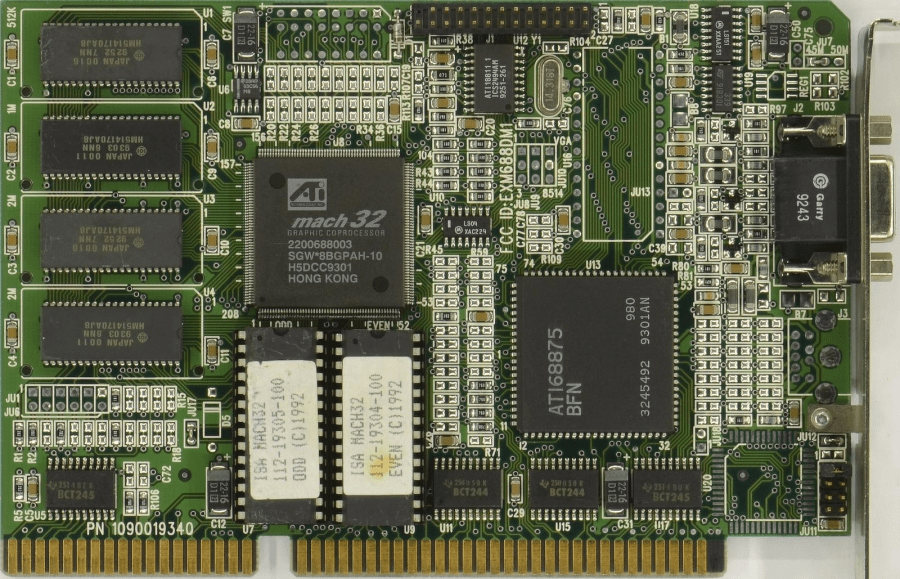 ATi Mach32 (Image: vgamuseum)
ATi Mach32 (Image: vgamuseum) 3dfx Voodoo (SST-1) from 1996
After about two years of development, in October 1996 3dfx Interactive presented the Voodoo Graphics (code name SST-1), a 3D graphics chip that, unlike the competition at the time in the form of the Nvidia NV1, was a pure 3D chip without 2D functionality therefore needed a separate 2D map in the same system.
At that time 3dfx Interactive was still operating exclusively as a manufacturer of graphics chips and in this role supplied the manufacturers Diamond and Creative, which are still known today, as well as the forgotten Miro, Orchid, VillageTronic and Quantum3D .
- 135 MHz RAMDAC
- 50 MHz PixelFX pixel processor
- 50 MHz TexelFX texture processor
- 4 MB EDO-VRAM with 50 MHz memory clock and 2 × 64-bit dual-channel memory interface
- 2 MB texture memory
- 2 MB framebuffer
One of the most popular graphics cards at the time was the Diamond Monster 3D, which was often combined with a Matrox Mystique and thus used its 2D functionality. The 3D graphics card with Voodoo Graphics and the 2D graphics card were connected using the so-called “loop cable”, and the 2D signal was then looped through
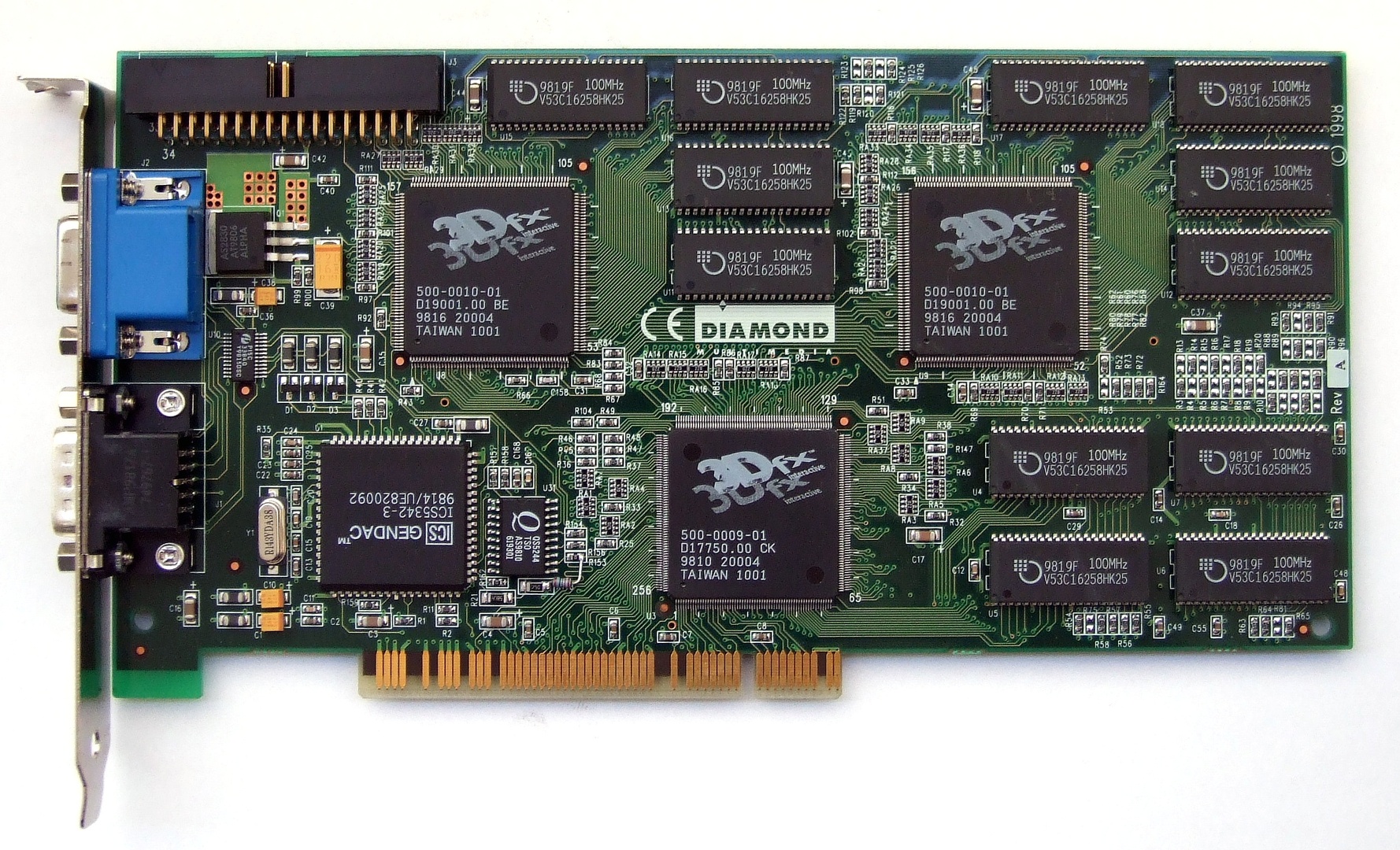 Diamond Monster 3D II with Voodoo² from 3dfx Interactive (Image : Vgamuseum, CC BY-SA 3.0)
Diamond Monster 3D II with Voodoo² from 3dfx Interactive (Image : Vgamuseum, CC BY-SA 3.0) Nvidia Riva128 from 1997
After the unsuccessful Nvidia NV1 from 1995, which was manufactured by SGS Thomson Microelectronics and marketed as Diamond Edge 3D, the Riva128 from 1997 should represent the first successful 3D graphics card from Nvidia.
- PCI and AGP 2X
- 100 MHz chip clock
- Direct3D 5 and OpenGL
< li> 4 or 8 MByte SGRAM with 128-bit memory interface
With support for DirectX 5.0 and a fill rate of 100 MT/s as well as up to 8 MByte with 128 bit connected SGRAM, the Riva 128 represented serious competition to the 3dfx Voodoo Graphics, which primarily served the Glide interface.
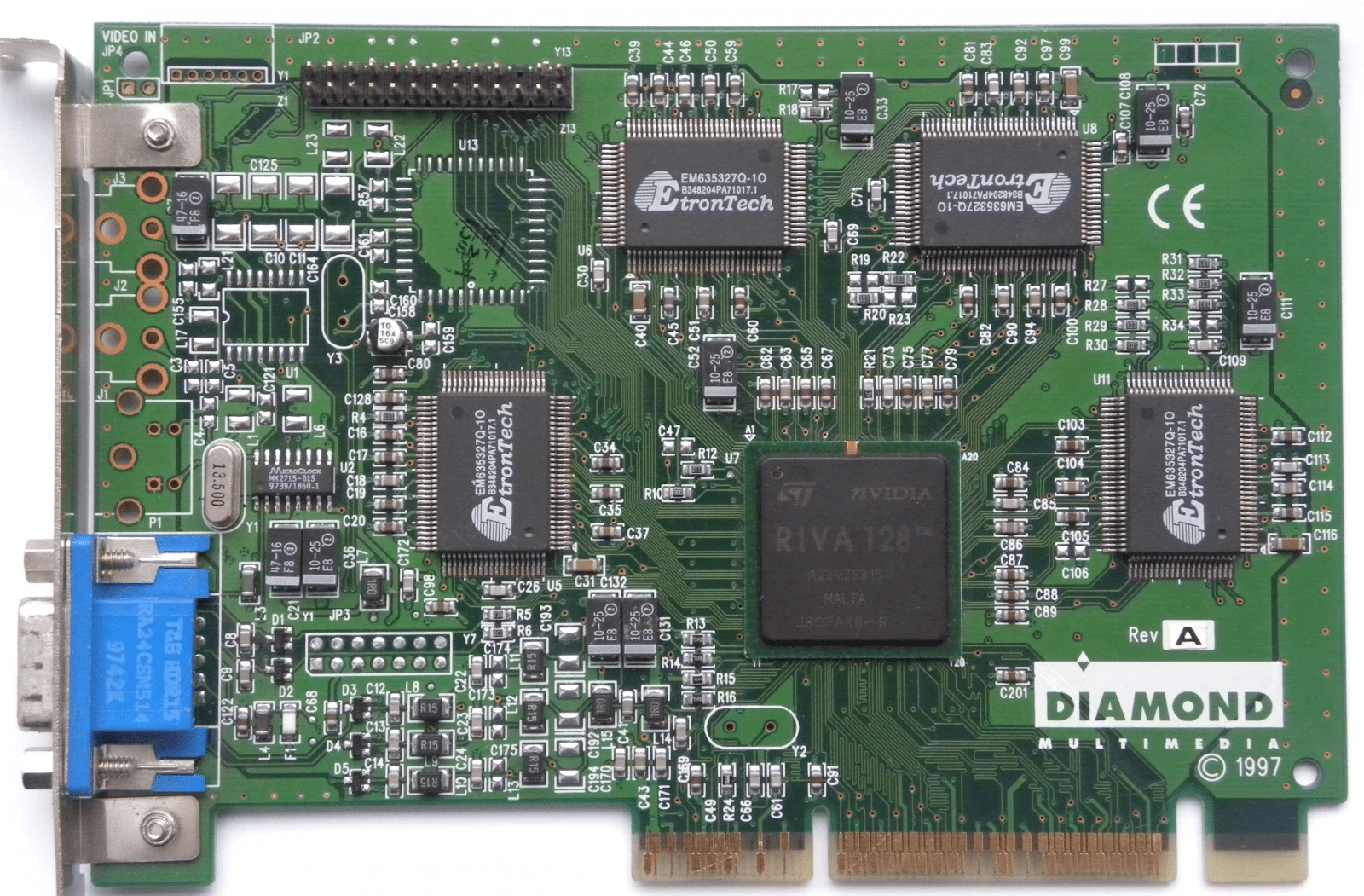 Nvidia Riva 128 (Image: vgamuseum)
Nvidia Riva 128 (Image: vgamuseum) < h2 class = "text-width text-h2" id = "section_cb_retrofeedback"> C: B_retro Feedback
Feedback is always welcome
The editors are happy to receive constructive criticism, praise, and suggestions, in order to be able to align the series even more closely to the wishes of the readership in the future. With this reading material in their luggage, the editors wish you a relaxing Sunday.
C: B_retro Review
The last ten issues in the overview
The last 15 topics from previous editions of C: B_retro :
- C: B_retro Ausgabe_79 : Nokia Communicator
- C: B_retro Ausgabe_78 : The first Microsoft Xbox
- C: B_retro Ausgabe_77 : The Sinclair ZX81
- C: B_retro Ausgabe_76 : The perfect gaming PC for 1999
- C: B_retro Edition_75 : The first MacBook Pro with Intel Core Duo
- C: B_retro Edition_74 : Star Wars : Knights of the Old Republic
- C: B_retro Issue_72 : A look at the history of PC benchmarks
- C: B_retro Issue_71 : The Nintendo GameCube
- C: B_retro Issue_70 : The Sega Game Gear
- C: B_retro Issue_69 : The Legend of Zelda
- C: B_retro Issue_68 : The Nintendo Entertainment System
- C: B_retro Edition_67 : Microsoft Windows 98
- C: B_retro Edition_66 : The Sega Saturn
- C: B_retro Edition_65 : Duke Nukem 3D
< li> C: B_retro Ausgbae_64 : Windows Vista in the test
- C: B_retro Ausgabe_63 : The GeForce 2 Ultra
Even more content of this kind and many more reports and anecdotes can be found in the retro corner of the ComputerBase forum as well as in the subject areas C: B_retro and Retro.
This article was interesting, helpful or both? The editors appreciate every support from ComputerBase Pro and deactivated ad blockers. More about advertisements on ComputerBase.
